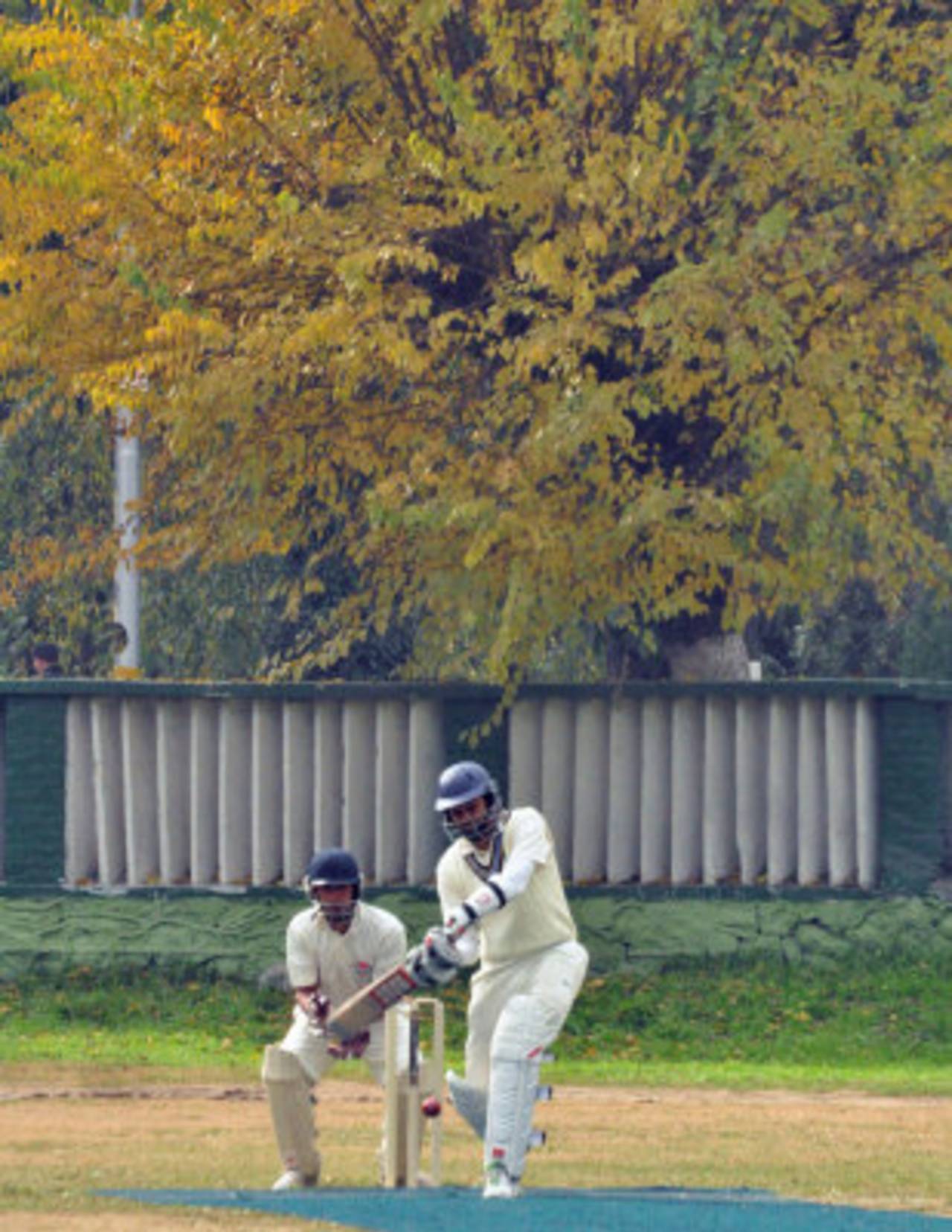Half-volleys in the Valley
A team of middle-aged Rotarians from Kolkata didn't know what to expect when they asked the army chief in Kashmir to let them visit and play cricket with the locals
Mudar Patherya
17-Nov-2011

The Rotarians play in Srinagar • Mudar Patherya
For decades the Indian army struggled to contain Kashmiri separatists, using military presence, profiling, and other pressures considered too impolite to mention in a cricket article. When Lt General Syed Ata Hasnain took over as General Officer Commanding of India's most troubled state in late 2010, he pencilled across these established no-brainers to pluck an unusual rabbit out of his beret. Cricket.
Cricket? His protocol-worshipping colleagues in fatigues probably sneered at it, but Hasnain was convinced the game would make the difference, in possibly the most daring attempt by any army anywhere in the world to control dissenting action.
This was the Lt General's rationale: cricket is religion in Kashmir, but there were hardly any pan-Kashmir cricketing opportunities. Kashmir's cricket heroes lay across either the mountains or the line of control. The state needed some of its own; for long, the principal occupation of young Kashmiri was to pelt stones at the hukoomat(authorities). Perhaps what they needed was simply an alternative to take them off the streets. The young Kashmiri watched the IPL with awe and wondered whether the tournament's rub-off would ever extend to him.
Hasnain blended these realities into a unique cocktail - a cricket tournament that would cover all the districts of Kashmir, accommodate as many youngsters as possible, create a tournament along the lines of the IPL, establish a unique identity for these teams (Srinagar Sherdils, Anantnag Arsenals, Budgam Blasters), offer attractive prize money (Rs 500,000 for the winners), create a new month-long talking point for the average Kashmiri, and give the word "target" a new connotation for the locals.
By the time the tournament ended in August 2011 - within the first eight months of Hasnain assuming office - 193 teams had participated, nearly 4000 young Kashmiris had been engaged, the finals played in Ramzan by fasting teams, and the consensus was that the tournament had lifted spirits in a valley marked by decades of attrition.
Learning of Hasnain's views on the game, our team of Rotarian cricketers from Kolkata emailed him a brief request: "We are interested in coming to play your boys across Kashmir. Would this interest you?" Hasnain replied, quick as second slip reacting to a passing snick: "Not only interested but willing to host your team across Kashmir. Any date after 30 October ideal."
And that is how our team of 19 incurables - industrialists, businessmen, professionals and the self-employed, with an average age of 42 - found ourselves flying from Kolkata to Srinagar on November 4.
Our tour was not the result of a whim of a man in power; it was part of a deliberate strategy to send out a message nationwide: that things were rapidly on the mend in Kashmir, and if a team of civilians could go from place to place - Anantnag, Budgam and Srinagar - and play cricket without a care in the world, then more teams and tourists could possibly do the same; and that if more such teams did, more player-to-player friendships would prevail. If more such friendships took over, the returns would endure in diverse ways across the decades.
So did we win? Of course not. The average Kashmiri we played was 20 years younger. They hit parabolic sixes that we watched with palms shading our eyes. They bowled with such ferocity that our non-strikers ushered incoming batsmen in with "Welcome to Australia." They plucked catches out of the air that made the batsman raise his bat towards the fielder out of respect while continuing to walk back to the pavilion.

The ever-present army: here, even the toss is controlled by them•Mudar Patherya
But this is what our team did achieve: the recognition that Kashmiri cricketers are people like us, the realisation that there are only three turf wickets in the whole of Kashmir, the conviction that Kashmir can seep into the mainstream consciousness if their youngsters are brought to play in other cities in the country.
What we will remember of these young Kashmiris is not so much their cricket as their character: they took their main bowlers off and put spinners on when they realised that their pace would be too hot for our ageing batsmen; they sent in their fielder when one of ours injured his finger; when any of them noticed our English willows, they would say only say "Bahut mehengi hai" (It's expensive), but when we admired any of their Kashmir willows, they would immediately say, "Hoi gayi aapki! (It's yours!) Please accept it as my humble gift"; after a match ended, the local captain would say, "Aap bahut door se aaye hain. Aap aaiyiye hamaare ghar, kuch sev toh khilaane ka mauka miley" (You've come from far away. Please come home so we get the opportunity to feed you our apples). When one of our batsmen was dismissed after scoring a half-century, three of their players ran in to pat his back; when they missed our bat's edge or an appeal was turned down, their response was a stoic smile; the only sledging these Kashmiris are good at it is off the snowy slopes of their great mountains.
And this is why we need to preserve the cricketing Kashmiri. He still represents the simple-mindedness towards the world as it used to be and still plays the game as it should be.
Once a professional cricket writer, Mudar Patherya is now a communications consultant. He lives his passion for the game through wicketkeeping. He also cleans lakes and plants bird boxes on trees